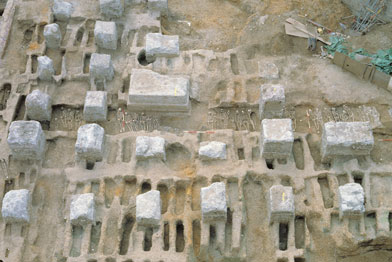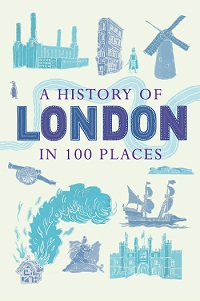David Long’s new book A History of London in 100 Places tells the capital’s incredible history through 100 buildings, details and places, from Roman barges to Boris Bike stations. In the second of three exclusive extracts for The Dabbler, David peers into a medieval plague pit…
London’s mass graves and plague pits, while clearly numerous, seem sometimes to be outnumbered by the legends that surround them. For example, that a seventeenth-century lad fell into one of them and was forced to gnaw on the bones to sustain himself before they pulled him out. That the basements at Harvey Nichols are shallower than normal because this was thought preferable to digging out all the corpses. And that work on the Victoria Line in the 1960s had to stop temporarily when a tunnelling machine beneath Green Park began to grind up hundreds of human bones after unexpectedly hitting an old plague pit.
It is similarly said that there are more dead bodies in the non-conformist Bunhill Fields cemetery off Old Street than living in the whole of Southampton – although this could actually be correct, and the name really is a derivation of ‘Bone Hill’. It is also known that during the plague itself two chancellors and three Archbishops of Canterbury all died in very quick succession, and it is likely that the large black slab in the Westminster Abbey cloisters conceals remains of the abbot and more than two dozen of his monks who also succumbed.
In all probability we will never know the true number of deaths, but genuine plague pits are still being discovered on a fairly regular basis and they can provide a fascinating glimpse into these turbulent years of London history. In the 1980s, for example, excavations at East Smithfield, between the buildings of the old Royal Mint and the Tower of London, at first revealed a fairly orderly pattern of burials – that is, more like a conventional graveyard. But a further more detailed examination of the bones quickly established that the bodies were associated with a single catastrophe, the Black Death, and not with the normal mortality patterns for Middle Age London.
With bodies stacked five deep, the find provided an important opportunity to study plague victims’ bodies in the greatest detail, and to date East Smithfield is the most fully analysed site of its kind anywhere in Europe.
In part, the greater than normal interest in the site came about because it was thought that ‘dental pulp’ from the skeletons could in some way come to the aid of modern medical science (possibly even in the treatment of HIV, as a mutant gene that offers some immunity to this is now believed to have its origins in the Black Death). Scientists from home and abroad were also keen to sequence the genome of the bubonic plague itself, hoping that it would prove possible to track changes in the evolution and virulence of the pathogen over time.
Unfortunately it has so far remained unclear what renders the disease quite so deadly – extraordinarily it still kills approximately two thousand people per year globally – but almost certainly it is this knowledge that a mass killer lurks unseen in the soil of modern London that explains the fascination we still have for plague pits, whether they be lost, found, real or imagined.













That Green Park tubeline story is often wheeled out – very gruesome and always carries a hint of a James Herbert-style horror story- Charterhouse square is definately the site of a large plague pit, as is aldgate circus
Thanks David – horribly compelling topic.
I stumbled across this site identifying London’s plague pits:
http://www.historic-uk.com/HistoryMagazine/DestinationsUK/LondonPlaguePits/
As worm suggests, Charterhouse Square covers a plague pit that was unearthed last year during Crossrail works. It housed perhaps 50,000 bodies.
I also discovered that Islington Green is above one. Part of the space is currently closed for work on its new war memorial, a giant circle of granite, which started sinking shortly after its erection…
Every now and then somebody contracts the plague from prairie dogs in the grasslands of eastern Colorado. It has been quite a while since I read the Denver papers, but as I recall most of the sufferers recover after treatment with antibiotics.